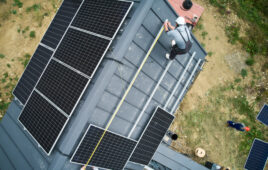
By Bobby Naimool, Pre-Sales Engineering Manager, Trina Solar US
The solar industry is undergoing a remarkable transformation due to two ingenious advancements: 210mm n-type TOPCon PV technology and low-voltage, high-string-power system design. These breakthroughs are revolutionizing efficiency, cost-effectiveness, and compatibility to significantly lower levelized cost of electricity (LCOE) in the utility-scale solar sector.
But don’t take my word for it; the numbers speak for themselves. Black & Veatch (B&V) conducted a comprehensive LCOE assessment of Trina Solar’s 590W Vertex N modules against other n-type and pPERC PV modules. The assessment’s findings underscore Vertex N’s remarkable advantages when deployed in a low-voltage, high-string-power design.
Read on to learn more about this assessment and its impact on the utility-scale solar sector.
Conquering the Utility Solar LCOE Conundrum
In an industry characterized by its disruptive nature — we don’t call it the solar coaster for nothing — LCOE has emerged as the ultimate arbiter of a utility-scale solar project’s economic prowess.
This race to the lowest LCOE has pushed the adoption of larger solar cells, with module wattages and efficiencies soaring to new heights, but with a corresponding increase in module size. However, this trend has, naturally, raised concerns about potential cost escalations due to heavier mechanical loads and added structural demands since bigger modules require more support racking, wiring, and tracker steel.
Additionally, the future generation of solar panels must be compatible with existing and future inverter and tracker technologies.
At the same time, the recent proliferation of high-powered, high-efficiency modules by Tier 2 manufacturers has intensified the competitive landscape. These modules, often with less-expensive prices, might seem like a wise investment at first glance, but they frequently leave developers and EPCs questioning if Tier 2 modules can deliver the efficiency, power output, and reliability necessary to impact performance and lower project LCOE over the system’s lifetime.
As the industry grapples with these challenges, two critical factors arise as driving forces: upfront cost optimization and long-term performance sustainability.
Against this backdrop, the dichotomy between P-type and N-type modules unfolds as a fascinating dynamic, reflecting the complex interplay between immediate cost savings and continuing project value.
The appeal of P-type modules lies in their lower upfront costs and enticing pricing structures. However, a deeper evaluation uncovers a nuanced truth: P-type modules may offer an initial advantage, but N-type TOPCon’s superior long-term performance and lower degradation rates deliver cost benefits over the project’s lifetime.
With plant owners, developers, and EPCs needing to calculate all of these variables in the overall LCOE equation, they face the pressing question of how to effectively lower LCOE while maintaining a competitive edge.
Trina Solar’s Vertex N effectively addresses these concerns.
The Pinnacle of Decision-making: Where CAPEX Meets Long-term Performance
In comparing Trina’s 590W Vertex N to generic 610W N-type 182mm cell, 590W pPERC 182mm cell, and 565W N-type 182mm cell modules, B&V’s assessment showed that Vertex N delivered cost benefits in several critical aspects:
- Lowest LCOE: Vertex N modules boasted the lowest calculated LCOE and outperformed the competition by coming in $0.45 less than the next lowest module, the Generic 610W.
- Maximized CAPEX and BOS Savings: The assessment identified Vertex N modules as having the ability to accommodate the most DC power per string circuit while optimizing the tracker length for maximum CAPEX savings. Compared with P-Type 590W modules, Vertex N reduced total initial costs by approximately $1.25 million, or $0.025 per watt, due to needing less DC wiring.
- Unmatched Power Production: Vertex N delivered the best power production per kW, highlighting its real-world efficiency and performance.
- Outperforming Higher Wattage Modules: The 210mm n-type TOPCon Vertex N beat the higher-wattage 182mm n-type module and outperformed it in CAPEX savings, with approximately $547,000 in savings, or $0.0109 per watt.
- Surpassing Lower Wattage Modules: Compared to lower wattage n-type modules, Vertex N’s CAPEX savings amounted to $1.63 million, or $0.0326 per watt.
The heart of this innovation lies in Vertex N’s superior attributes, which have set new industry benchmarks, combined with a low-voltage, high-string-power system design to amplify performance for lower LCOE.
Using this design, N-type TOPCon modules allow more modules per string, which minimizes tracker lengths and requires fewer wire harnesses and other components, significantly reducing racking and electrical BOS costs. The design drives cost-efficiency and optimizes land usage—a crucial consideration in an industry teeming with high real estate competition. Associated labor and transportation costs also see a reduction.
Less is More: Maximizing Energy Output Through Power Density
However, as with any breakthrough, trade-offs persist. N-type modules bring about an LCOE-related problem linked to the size of the modules. While increasing current density allows for more modules per string, this shift comes at a price: limitations in the number of strings that can be integrated into the inverter. In contrast, modules with higher voltages can incorporate more strings.
This raises the pivotal question of power density within the context of stringing. Here, the correlation with LCOE becomes evident. Power density—the ability to pack more power into strings—aligns seamlessly with LCOE reduction. The mechanical balance, installation, and associated costs benefit from this condensed power density, offering an attractive proposition for developers seeking cost optimization and long-term performance excellence.
Widespread Compatibility, Adaptability, and Availability
Vertex N seamlessly integrates with existing and future inverter and tracker technologies, ensuring that solar infrastructure investments remain relevant and functional as the industry evolves.
Vertex N isn’t just pushing the boundaries of performance; it’s revolutionizing utility-scale project economics now and for years to come. Learn more about the benefits of Vertex N and contact Trina Solar US sales representative here.
Sponsored Content by Trina Solar





Excellent insight into an industry with so much potential, but is still a long way from having standards implemented to allow for the integration of various elements creating unified and diverse systems that can address many conditions that answer customer wants and needs. Trina is certainly on the leading edge of that by what I see.